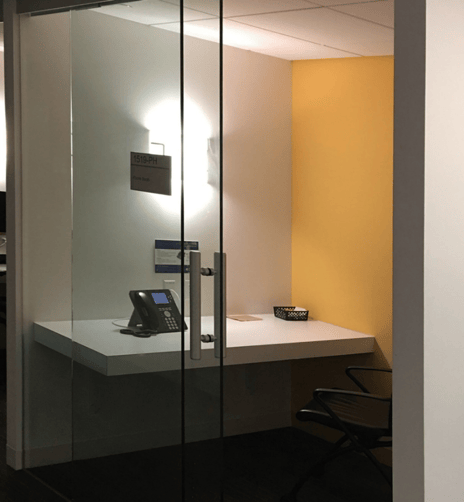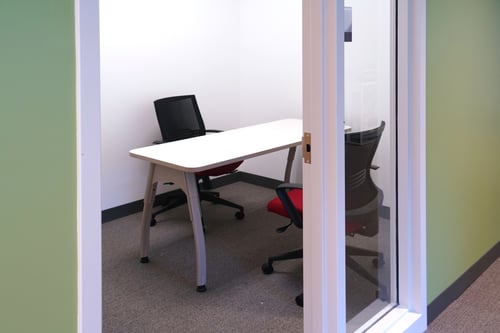In a recent blog, one of my colleagues wrote about the flow state at work, a state in which you are so focused that your tasks seem almost effortless. If you are trying to achieve this deep state of mind in your workplace, having a quiet retreat is helpful. If you have a private office, that’s likely your quiet space. However, today’s modern, open-plan workplace may not include the rows of traditional private full-walled offices in which a person can truly focus. So how can one find a workspace to encourage the flow state?
Let’s discuss a few options for space in which focused work can be done – spaces that can be included as part of the open office environment.Personal Focus Space at Work
Today’s mobile workforce may spend a portion of their time away from the main office. When in the office, they typically use open office workstations or touchdown stations where workers are in relatively close proximity to each other. No matter how conscientious your coworkers might be, there will always be a buzz in the air in a busy office that can kill your focus when you need it most. Your workplace might include a few private offices, but fewer workers today have that place where they can cast aside the distractions of the office floor.
One option to the traditional private office is a getaway booth. These booths are often just that – a closet or phone booth-sized room that would include a work surface and seating. These are great if the need is only for a short while, but can be a cause for claustrophobia if used all day. Plus, the limited space may not provide the ability to spread out work materials. If your task requires several hours of head-down quiet work, or room to lay out papers or books, a larger version of the getaway booth, which could be thought of as a getaway room, is required.
The image below is a spacious version of a private booth, or getaway room, where focused work can be done. These booths take up about the same amount of floor space as a typical 8’ x 8’ office cubicle, but have full walls, a ceiling, and a closable door. There are companies who manufacture these booths as pre-fabricated units that can be moved around during an office reconfiguration, providing office layout flexibility.

Getaway room in an open office
Slightly frosted glass offers relief from visual distractions and some privacy, but another way to relieve visual distractions would be to locate the rooms somewhere off the beaten path, away from the hustle and bustle of the open office.
One concept for a modern open office layout where the areas for focused work are separated from areas of phone calls and casual collaboration is the idea of the Eudaimonia Machine, which was explored in an earlier Fentress blog. In general, it is an office layout with a linear series of rooms or stages that takes the occupant through increasingly deeper levels of contemplation, culminating in areas for focused work where the flow state can be achieved.
Focused Collaboration
Focused work does not necessarily mean one person working alone. Focused collaboration among small teams with as few as two people working on a single task or project is also a characteristic of the modern workplace, and dedicated spaces should be provided where small teams can closely collaborate.
At an architectural firm I once worked for, we had two conference rooms that often served as places where this focused collaboration could take place. Employees would reserve (or in some instances, commandeer) one of the rooms and shut themselves in, away from the office din. However, there were only two of these conference rooms. Being a busy firm, these spaces were often needed for, well, conferences.
In some offices, small huddle tables might be set up adjacent to the main workroom. While these spaces might work for casual collaboration, or to kick around some ideas with a colleague, their location and openness relative to the main workspace in the open office offers no respite from the distractions of a busy and buzzing workplace.
So how can an open office design allow for small team focused collaboration? Provide a huddle room or collaboration booth.

A small room for focused collaboration
Similar to the getaway booth or getaway room that affords an employee the ability to shut out distractions and get into the flow state, the collaboration booth is an enclosure that serves a similar purpose for small groups. This room has a work surface, seating for two to four people, and is often equipped with a video monitor.
These spaces have walls and doors that can isolate the room from the main office. If located away from the noisier parts of the office, the room can be open on one side, like a cabana. These mini-conference rooms are small enough that they don’t take up too much real estate. Several can be provided, eliminating the coveting of conference rooms and, potentially, the requirement to reserve such spaces.
Find Your Peace
Not all head-down work requires the same deep level of focus and may not need spaces that are completely private. Varying levels of focus can be attained through space designs that are more open, such as a collaboration booth with low sound-absorbing walls that keep outside noise mostly out and the collaborators’ voices mostly in. Whatever level of peace you or your team requires to achieve task-performing nirvana, it can still be accomplished in the modern, open office. Attention simply must be given to providing spaces where the distracting sights and sounds of the busy workplace are minimized.









.jpg)
.jpg)
-1.jpg)
.jpg)
.jpg)
.jpg)
.jpg)
.jpg)

